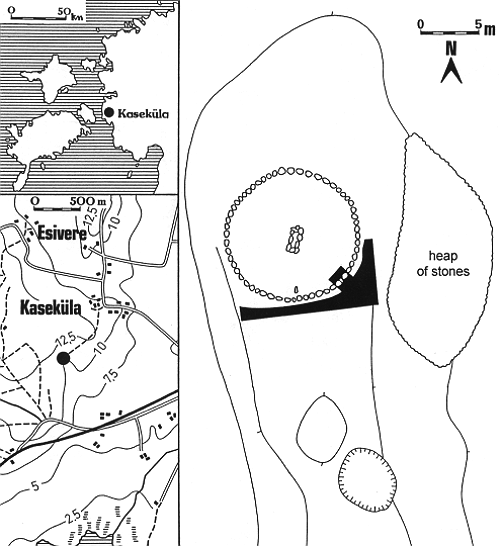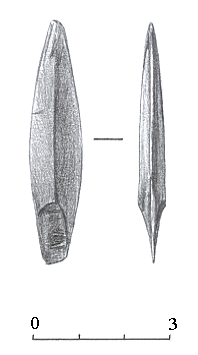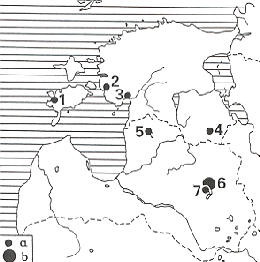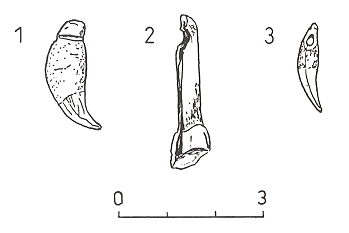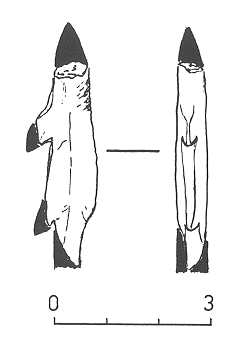ARCHAEOLOGICAL EXCAVATIONS OF THE STONE AGE SETTLEMENT
SITE AND RUIN OF THE STONE CIST GRAVE OF THE EARLY METAL AGE IN
KASEKÜLA
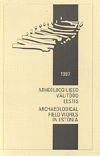
Aivar KRIISKA, Lembi LÕUGAS and Ulla SALUÄÄR Tartu Ülikool
(University of Tartu), Lossi 3, EE-2400 Tartu,
Ajaloo Instituut (Institute
of History), Rüütli 6, EE-0001
Published: Arheoloogilised välitööd Eestis 1997. Tallinn 1998, 30–43. The stone graves and the Stone Age
settlement site of Kaseküla are located in Läänemaa, about
0.5 km to the southwest from the heart of Kaseküla village (Fig. 1).
The seven stone graves, located in a single group, were discovered by Vello
Lõugas in 1971 (Mandel 1993). In 1973, Mati Mandel excavated the
northernmost one, which appeared to be a stone cist grave with one circular
wall. Below and around the grave, the cultural layer of a settlement site
of an earlier date was discovered (Mandel 1973; 1975, 74).
New excavations on the monuments
of Kaseküla took place in 1997. These were financed by the Estonian
Science Foundation (grant no 2254), Estonian Fund for Furthering Culture
and the Fishing Industry of Pärnu. An excavation of 22 m² was
dug to the south of the grave investigated in 1973, between two graves
(Fig. 1). A part of the ruin between the two graves was cleared and the
cultural layer of the Stone Age settlement site under it excavated. The
soil was screened, mesh of the screen measured 2–5 mm. RUIN OF THE GRAVES The ruin consisted of granite and
limestones with the diameter 5–20 cm, and the soil between the
stones, which was blackish-brown and rich in organic or heavily sodded.
The thickness of the cultural layer of the grave was 40–55 cm.
In the excavation the stones of the ruin were preserved in four layers
at the most. Under the ruin outside of the circular wall, an oval pit was
discovered, 25 cm deep, measuring 1.4 x 0.85 m, dug in the original soil
and filled with stones. The cultural layer in it bore heavy burning traces
— granite stones were swelled and crumbling, and limestones were
red-coloured or even calcified. Relying upon the potsherds found there,
this entrenchment ought to belong to the Metal Age and might be related
to the burial rites.
In the western part of the
excavation, three separately situated fragments of human skull(s) were found. Most
of the found potsherds were very small. Still, fragments of five vessels
could be distinguished (Fig. 2). The fragments of the first vessel with
smoothed surfaces were found in the western part of the excavation. This
was a vessel with the walls about 1 cm thick and the tapering rim turned
inwards. The clay contains stone rubble. The fragments of the second vessel
were located in the same western part of the excavation. The walls of this
vessel were 0.8–1.0 cm thick, its surfaces were similarly smoothed,
but it had been bigger than the first one. The fragments of the third vessel
were found in the eastern part of the excavation. This had been smaller
than the others, and the walls, about 0.6–0.7 cm thick, were decorated
with horizontal lines of elongated notches.
Fig. 1. The location map of archaeological monuments in Kaseküla and the excavation of 1997. The two bigger sherds of the
fourth vessel were found in the above-mentioned entrenchment. The vessel
has been rather big, with semierect walls and the orifice turned slightly
inwards. The clay contains stone rubble. Unlike the other vessels, this
one has been smoothed on the outside and striated on the inside. The inner
surface of both sherds is sooty. The fifth vessel is small, with the walls
0.4 cm thick and the tapering rim turned inwards.
The pottery is not easily datable.
The bronze razor found from the cist of the grave, excavated by M. Mandel,
dates the grave to the Late Bronze Age (Lang 1996, 297). The head of the
shepherd's crook pin and the pottery found from the ruin were dated by
Mandel to the Pre-Roman Iron Age (Mandel 1975, 74, Fig. 2). The excavations
of 1997 did not enable to specify these dates, as the found pottery may
be contemporaneous either with the burial in the cist or the later secondary
burials. 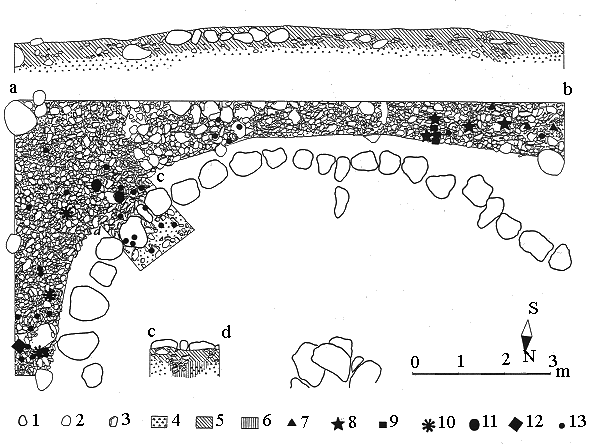 Table 1. Finds from the stone grave and the Neolithic settlement site of Kaseküla
THE STONE AGE SETTLEMENT SITE The cultural layer of the Stone Age was the 25 cm thick upper part of the pebbly gravel layer. This differed from the original soil with its darker colour, and contained finds and bones. No constructions were discovered in the excavation area. The only clearer concentration of charcoal was found in the eastern part of the excavation. The 14C dating of the sample gathered there gave the result 510±60 years (Ta-2635), so it does not belong to the Stone Age. An amount of 160 potsherds is related to the cultural layer of the settlement site (finds AM 807:1–453). Relying on their shape we may presume that the vessels have been rather capacious and straight-walled. Rim and bottom fragments were not found. Thickness of the wall could be measured on 38 sherds. It varied from 9 to 14 mm (average 10.7 mm). Most of the sherds (25) are 10–11 mm thick. The potsherds are rather badly preserved and tend to crumble. The vessels have mostly been made of clay mixed with limestone (this was the composition of 133 sherds). In some cases, granite rubble has also been added. 24 fragments (14.4 %) are very porous and, relying upon the traces, have contained some plant admixture. A few fragments contain only granite rubble in the admixture. Limestone has not been discovered before in the composition of Estonian Stone Age pottery. It is quite rare also in later pottery. Limestone admixture has been discovered, for instance, in the pottery from the Poanse tarand-grave in West Estonia (Mandel 1978, 79). 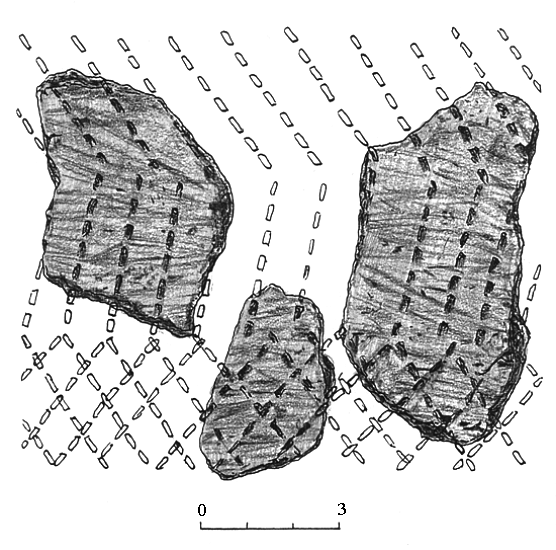
Fig. 3. Geometric ornamentation of comb impressions on the Late Comb Ware of Kaseküla (AM 807:338, 316, 340). It was possible to study the outer surface of 95 and the inner surface of 68 potsherds. The surfaces are either striated (65.3 % of the outer and 35.5 % of the inner surfaces) or smoothed (34.7 % of the outer and 64.7 % of the inner surfaces). 38 sherds were ornamented (23.8 % of the total). The only decorative elements are comb impressions. They are mostly long and comparatively wide. On one vessel the impressions are diagonal in opposite directions or crossing, located in zones (Fig. 3). The ornamentation, surface finishing, thickness of the walls and the use of organic admixture in the composition of clay relate the pottery of Kaseküla to the Late Comb Ware. Analogous comb impressions, sometimes forming rather complicated geometric ornaments, are typical of Late Comb Ware. Pottery from Kudruküla and Väiküla (Kriiska 1995, 92) on the lower reaches of the Narva River offers good parallels, and so do the finds from Tamula in South-East Estonia (Jaanits 1984,190–191). The type of seven of the found
potsherds
is indeterminate. These fragments are 5–8 mm thick, with smoothed
or striated surfaces, containing stone rubble in the admixture. One fragment
is decorated with horizontal rows of small oblong grooves. The presumable
impressions of hair on the surfaces remind of corded pottery (see e.g.
Kriiska 1996a, 416).
In 1997, 648 stone finds were gathered,
526 (81.2 %) of them are quartz, 72 (11.1 %) flint, 10 (1.5 %) quartzite,
3 (0.5 %) Baltic red porphyry and 37 (5.7 %) of other rocks, mostly sandstones.
The majority of the finds were flakes, the number of blades is 41.36 of
them were of quarts (6.8 % of quartz and quartzite finds). Quartz blades
are 0.9–3.8 cm long (55.6 % are less than 2 cm long), 0.3–1.6
cm wide (66.7 % are less than 1 cm wide) and predominantly with one ridge
(27 blades) or without ridge (8 blades). Four blades are of flint (5.5
% of flint finds). They are 1.2–2.2 cm long and 0.6–1.0
cm wide. One blade is of some other rock. Only four quartz and one flint
specimen could be regarded as cores. These are mainly small and with one
striking platform. The defects of surface structure of quartz cores indicate
the application of bipolar technique — the
lump of raw material has been processed on a stone base with a stone tool. 18 of the objects (2.8 % of stone finds) bear traces of secondary processing. Most of them are scrapers (77.8 %). 10 of the 14 specimens are of quartz, one of flint (Fig. 4), one of quartzite and two of other rocks. All these are made of flakes and are triangular (5), trapezoid (5), segmental (1), polygonal (1) or irregular (2). The greater part of them are end scrapers, side scrapers, as well as side-and-end scrapers are less numerous. One-bladed scrapers prevail while three-bladed ones occur only exceptionally. The blade may be straight (8), convex (5), concave (2) or wavy (1). 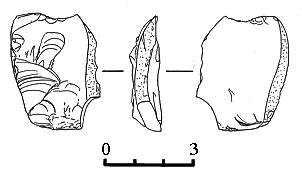
Fig. 4. Flint scraper (AM 807:223). Three burins were found (16.7 % of the objects of secondary processing), two of them made of flint and one of quartz. They are made of flakes and are triangular, round or irregular by shape. Two of them are angle burins and one is a dihedral burin. A small triangular quartz knife made of flake was also found.
ANIMAL BONES The rich and varied osteological
material consists of burnt and unburnt animal bones. Little fish bones
are remarkably numerous. Of the determined species, five bone fragments
belong to marbled seal, one to Greenlandic seal, three to elk, two to fox
and two to mountain hare. Of domestic animals, seven fragments belong to
cattle, three to goat or sheep, two to pig and five to dog.
Among fish bones, plaice (314 fragments),
perch (275) and codfish (157) prevailed. Some of plaice bones, relying
upon their size, seem to belong to halibut, which prefers more brackish
water than the present Baltic Sea and occurs only in the southern parts
of the sea. Unfortunately, size is a subjective criterion and thus the
precise determination of the species isimpossible. Eel (46 fragments),
pike (42), lavaret (20), pike perch (11), turbot (7), herring (2), and
also ide (6) and roach (3) were also represented among fish bones. The
herring bones probably belong to its smaller relative, Baltic herring.
Some fragments of birds' bones were also found but their precise determination
was not possible. All bones of domestic animals,
except at least one fragment of a dog bone, and also a part of the bones of wild
animals and fish come from the grave. Half of the bones of the domestic
animals were gathered from the first two layers of stones of the ruin of
the grave. The 41 bones of rodents are probably also connected with these.
From an entrenchment probably connected with the grave, bones of cattle
and sheep or goat, as well as of seal and fish, were obtained. The latter
may have fallen there by chance, by the mixing of the soil layers, while
the entrenchment became filled. Among the neolithic material marine fauna,
seals and fish, prevail, which is characteristic of coastal settlements
of that period. Both marine fish and fresh water fish are represented,
the latter may have lived in shallow waters near the coast.
Table 2. Mammals' bones found from Kaseküla in 1997. MAMMALS
I – Phocidae, II – Pusa hispida, III – Pagophilus groenlandicus, IV – Vulpes vulpes, V – Alces alces, VI – Lepus timidus, VII – Capra/Ovis*, VIII – Bos taurus*, IX – Sus domesticus*, X – Canis familiaris*, XI – Rodentia* * does not derive from Stone Age CONCLUSIONS The thickness and intensity of the
Stone Age cultural layer, as well as the small number of finds from the
area excavated in 1973, indicate that then the Stone Age cultural layer
was not excavated except for the 10 cm thick topmost part. The cultural
determination and dating of the Kaseküla settlement site —
Late Corded Ware culture and the beginning of the Bronze Age (Mandel 1975,
75; Jaanits et al., 1982, 106) — were not confirmed by the
new investigations in 1997. The find complex dates the settlement layer
to the Late Neolithic and connects it with the Late Comb Ware culture.
Odd potsherds presumably belong to the corded ware, too. Potsherds of corded
ware occur in greater or smaller numbers in several Estonian Late Comb
Ware settlements, like Akali, Jägala, Kullamägi, Lemmetsa, Tamula
and Villa (Jaanits 1966, 64). The occurrence of potsherds of corded ware
can be explained by two different reasons: 1) people of the Corded Ware
culture have lived or acted there at some time, or 2) pottery may have
drifted between communities by contacts and trade.
The previous interpretations of analyses
of animal bones by K. Paaver (Jaanits 1992, 52–53; Kriiska 1996b,
5) must also be revised. Such association of animal bones indicates the
mingling of bones from the grave and the Stone Age settlement, thus conclusions
cannot be driven, relying upon them, about the economy of the settlement
preceding the grave. Leaving aside dogs' bones, none of the bones of domestic
animals found in 1997 can be definitely connected with the cultural layer
of the Neolithic settlement. Animal bones indicate that the settlement
of Kaseküla has been inhabited by a community with gathering economy,
strongly oriented towards the sea. Acknowledgements The authors wish to express their
gratitude for help and advice to the archaeologists Mati Mandel and Ilze
Loze, the artist Jana Ratas and Riina Vesi, the osteologist Liina Maldre
and all the members of the Kaseküla archaeological expedition.
Table 3. Fish bones found from Kaseküla in 1997. PISCES
References Edgren, T. 1984.
Kivikausi. — Suomen historia, 1. Espoo, 18–95.
Jaanits, L. 1966.
Venekirveste kultuuri asulatest Eestis. — Pronksiajast varase
feodalismini. Tallinn, 60–66.
Jaanits, L. 1984.
Die kennzeichnende Züge der Siedlung Tamula. — Fenno-ugri
et slavi 1983. Iskos, 4. Helsinki, 183–193.
Jaanits, L. 1992.
Põllumajanduse eelduse kujunemine. — Eesti talurahva ajalugu.
Tallinn.
Jaanits, L., Laul, S., Lõugas,V., Tõnisson, E. 1982. Eesti
esiajalugu. Tallinn.
Kriiska, A. 1995.
Narva jõe alamjooksu ala neoliitiline keraamika. — Eesti
arheoloogia historiograafilisi, teoreetilisi ja kultuuriajaloolisi aspekte.
Muinasja teadus, 3. Tallinn, 54–115.
Kriiska, A. 1996 a. Archaeological excavations on the Neolithic site of
Riigiküla IV. — Proc. Estonian Acad. Sci. Social Sciences, 4,
410–419.
Kriiska, A. 1996 b.
Viron rannikkoalueen asutus ja pyyntikultuurin erikoistuminen. —
Muinaistutkija, 4, 1–6.
Lang, V. 1996. Muistne
Rävala. Muistised, kronoloogia ja maaviljelusliku asustuse kujunemine
Loode-Eestis, eriti Pirita jõe alamjooksu piirkonnas, I–II.
— Muinasaja teadus, 4. Tallinn.
Lõugas, L.,
Lidén, K. & Nelson, E. 1996. Resource Utilisation along the
Estonian Coast during the Stone Age. — Coastal Estonia: Recent
Advances in Environmental and Cultural History. PACT 51. Rixensart, 399–420.
Mandel, M. 1973. Aruanne
Kaseküla kivikirstkalme kaevamistest 1973. aastal. (Manuscript in
the archives of AI.)
Mandel, M. 1975. Ausgrabungen
der Steingräber von Kaseküla. — Eesti NSV TA Toim. Ühisk.,
1, 74–76.
Mandel, M. 1978. Über
die Ausgrabungen der Tarandgräber von Poanse. — Eesti NSV
TA Toim. Ühisk., 1, 78–81.
Mandel, M. 1993. Kaseküla
kivikalme 2139. (Manuscript in the archives of RMA.)
Meinander, C. F. 1939.
Pyheensilta stenåldersboplats. — Finskt Museum 1939, 28–42.
Pearson, C. & Stuiver, M. 1993. High-precision bidecadal calibration of
the radiocarbon time scale, 500 2500 BC. — Radiocarbon 35:1,
25–33.
Salo, U. 1997. lhmisen
jä1jet Satakunnan maisemassa. Kultuurimaiseman vuosituhannet. Suomalaisen
Kirjallisuuden Seura Toimetuksia, 677. Helsinki.
ARHEOLOOGILISED KAEVAMISED KASEKÜLA KIVIAJA ASULAKOHAL JA VARASE METALLIAJA KIVIKIRSTKALME ÄÄREVAREL Aivar KRIISKA, Lembi LÕUGAS ja Ulla SALUÄÄR Kaseküla kivikalmed ja kiviaja
asulakoht asuvad Läänemaal Kasekülas, küla tuumikust
u. 0,5 km edelas (joon. 1). Ühes rühmas paiknevad seitse kivikalmet
leidis siin 1971. aastal Vello Lõugas. 1973. aastal kaevas Mati
Mandel nendest kalmetest läbi kõige põhjapoolsema, mis
osutus ühe ringmüüriga kivikirstkalmeks. Kalme alt ja lähiümbrusest
leiti varasema asulakoha kultuurkiht, mis tookord arvati kuuluvat hilisesse
nöörkeraamika kultuuri ja dateeriti pronksiaja algusesse. Uued
kaevamised Kaseküla muististerühmas toimusid 1997. aastal.
22 m² suurune kaevand rajati
1973. aastal uuritud kalmest 1õuna poole, kahe kalme vahele (joon.
1). Puhastati välja osa kalmetevahelisest äärevarest ja
kaevati läbi selle all asuv kiviaegse asulakoha kultuurkiht. Äärevare
koosnes kõige rohkem neljast kivikihist ja orgaanikarikkast mullast.
Sellest sügavamal, kalme ringmüürist väljapoole jääval
alal, avastati u. 25 cm looduslikku pinda kaevatud lohk. 1,4 x 0,85 cm
1äbimõõduga lohus oli tugevasti põ1enud kive
ja sütt. Samast leitud keraamika järgi otsustades on see metalliaegne
sissekaeve, mis võib olla seotud matmisrituaaliga. Kaevandist leiti
inimese kolju fragmente ja savinõukilde. Killud pärinevad vähemalt
viiest, erineva suuruse, kuju ja pinnatöötlusega nõust
(joon. 2). Ühe väiksema nõu pind oli ornamenditud horisontaalsetes
ridades paiknenud piklike täketega; teisel oli vä1ispind silutud
ning sisepind riibitud. Kogutud keraamika on raskesti dateeritav. M. Mandeli
kaevatud kivikirstkalme kirstust leitud pronksist habemenuga pärineb
nooremast pronksiajast. Äärevarest leitud karjasekeppnõela
pea ja keraamika dateeris Mandel eelrooma rauaaega. 1997. aasta kaevamised
ei võimaldanud nendes dateeringutes teha olulisi täpsustusi,
kuna leitud savinõukillud võivad pärineda nii kirstu
matmise kui ka hiljem sooritatud järelmatuste ajast.
Kiviaja asula kultuurkiht oli kuni
25 cm paksune. See eristus looduslikust pinnasest tumedama värvusega
ning sisaldas leide ja luid. Mingeid kiviaegseid kinnisobjekte kaevandi
alalt ei avastatud. Asula kultuurkihiga seostus ligi paarsada väikest
savinõukildu. Killud olid halvasti säilinud ja murenesid kergesti.
Nende uurimine näitas, et anumad valmistati lubjakiviga segatud savist.
Vaid mõnel juhul oli lisatud ka graniidipurdu. Varem pole Eesti
kiviaja keraamikas lubjakivi lisamist savimassile täheldatud. Ka hilisemate
savinõude puhul on see väga harv nähtus. Kaseküla
kiviaja keraamika ornament (joon. 3), pinnatöötlus, seinapaksus
ja orgaanilise lisandi kasutamine vormimismassis, seovad selle hilise kammkeraamikaga,
millel on kõige lähemad vasted näit. Narva jõe
alamjooksu alalt Kudrukülas ja Väikülas, samuti Kagu-Eestis
Tamulas.
1997. aasta kaevamistel koguti Kasekülast
veel 648 kivileidu, millest 526 olid kvartsist, 72 tulekivist, 10 kvartsiidist,
3 Läänemere punasest kvartsporfüürist ja 37 teistest
kivimitest, peamiselt liivakividest. Enamus kivileidudest olid killud.
Teisese töötlusega esemeid oli 18 ja suurima rühma (kokku
14) moodustasid neist kõõvitsad (vt. joon. 4). Uuritsaid
saadi 3, s. h. kaks tulekivist. Leiti ka üks väikene killust
valmistatud kolmnurkse kujuga kvartsnuga. Lihvitud kiviesemetest saadi
üks kiltkivist nooleots (joon. 5). Luuesemetest leiti 3 hammasripatsit,
üks harpuuni- või ahinguots ja mõned töödeldud
luukillud. Ühel hammasripatsil on juureossa sisse 1õigatud
soon ja kahele puuritud auk (joon. 7).
Kogutud osteoloogiline aines, mis
koosneb nii põlenud kui põletamata loomaluudest, on arvukas
ja mitmekesine. See sisaldab iseäranis palju väikesi kalaluid.
Kaladest domineeris lest, ahven ja tursk. Esines aga ka angerjat, haugi,
siiga, koha, kammeljat, heeringat, säinast ja särge (vt. tabel
3). Kõik kodu- ja osa metslooma luudest saadi kalmekihist. Äärevare
alt avastatud süvendist saadud luud kuulusid veisele, lambale või
kitsele ning hülgele. Samas oli ka kalaluid. Neoliitilise ainese hulgas
domineerivad hülged ja kalad.
1997. aasta Kaseküla kaevamised
näitasid, et siinne kiviajast pärinev asulakiht tuleks dateerida
hilisneoliitikumi ning siduda hilise kammkeraamika kultuuriga. Osteoloogilise
leiumaterjali analüüs lubab väita, et Kasekülas on
elanud tugevasti merele orienteeritud püügimajandusega tegelev
kogukond. |
